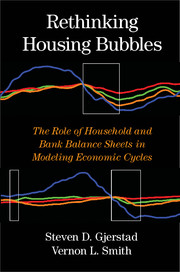 Rethinking Housing Bubbles
Rethinking Housing Bubbles Book contents
- Frontmatter
- Contents
- Acknowledgments
- 1 Economic Crises, Economic Policy, and Economic Analysis
- 2 Goods and Services Markets versus Asset Markets
- 3 Asset Performance
- 4 The Great Depression
- 5 The Postwar Recessions
- 6 What May Have Triggered or Sustained the Housing Bubble (1997–2006)?
- 7 The Bubble Bursts
- 8 Blindsided Experts
- 9 What Might Be Done?
- 10 Learning from Foreign Economic Crises
- 11 Summary: What Have We Learned?
- Index
- References
6 - What May Have Triggered or Sustained the Housing Bubble (1997–2006)?
Published online by Cambridge University Press: 05 June 2014
- Frontmatter
- Contents
- Acknowledgments
- 1 Economic Crises, Economic Policy, and Economic Analysis
- 2 Goods and Services Markets versus Asset Markets
- 3 Asset Performance
- 4 The Great Depression
- 5 The Postwar Recessions
- 6 What May Have Triggered or Sustained the Housing Bubble (1997–2006)?
- 7 The Bubble Bursts
- 8 Blindsided Experts
- 9 What Might Be Done?
- 10 Learning from Foreign Economic Crises
- 11 Summary: What Have We Learned?
- Index
- References
Summary
As home prices rose and hunger for high-yield investments grew, Sadek [founder of Quick Loan Funding] found his niche pushing mortgages to borrowers with poor credit. Such subprime home loans grew to $600 billion, or 21 percent, of all U.S. mortgages last year from $160 billion, or 7 percent, in 2001, according to Inside Mortgage Finance, an industry newsletter. Banks drove that growth because they could bundle subprime loans into securities…“I never made a loan that Wall Street wouldn’t buy,” Sadek says. He worked hard to build the business, he says, and the company did nothing illegal…with the support of Citigroup, which funded the loans, he pioneered lending to homebuyers with credit scores of less than 450.
Citigroup spokesman Stephen Cohen said the bank doesn’t comment on its relationships with clients.
“We made most of our money from selling loans to banks,” Sadek says…like many subprime companies, [he] specialized in…thirty-year mortgages that start with lower “teaser” interest rates and ratchet higher after two years.
A key selling point was the 50 percent rise in home prices nationally from 2001 to 2006.
Bob Ivry, Bloomberg News, December 18, 2007Since late 1997, more than $2 billion worth of community reinvestment loans have been packaged and marketed into securities…Every dollar taken off the originator’s books through securitization is a dollar available for new loans…securitization reflects a growing confidence among secondary market investors – many of whom, after all, are under no CRA obligation of their own – in the quality of these loans. I think that it proves we’re on the right track.
John D. Hawke, Jr.; Comptroller of the Currency; May 5, 1999- Type
- Chapter
- Information
- Rethinking Housing BubblesThe Role of Household and Bank Balance Sheets in Modeling Economic Cycles, pp. 146 - 172Publisher: Cambridge University PressPrint publication year: 2014


